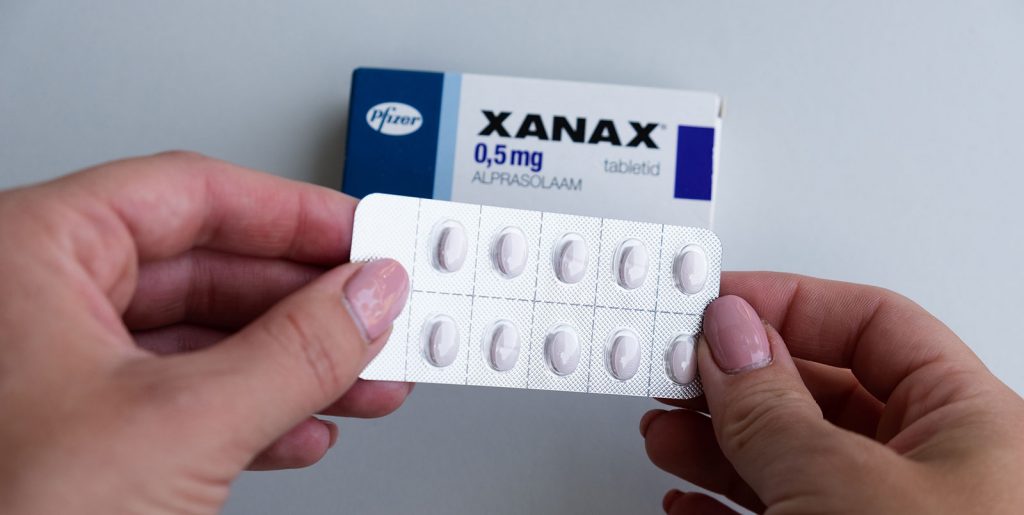Xanax is the go-to medication for people who suffer from anxiety disorders or manic episodes. The drug can enhance the activity of certain neurotransmitters to create a sense of relaxation and drowsiness.
On top of that, Xanax can improve your state of mind and some studies suggest that it can treat depression. Because of that, many people are quick to ask their general physician for a prescription.
However, most users don’t take into account that Xanax can be highly addictive. Due to the way the drug affects your brain chemistry, it can lead to a substance abuse disorder in no time. Plus, without a proper rehab plan, overcoming the dependency can prove challenging.
So if you’re looking for Xanax addiction treatment in New Jersey, we can help at the Garden State Treatment Center! In this article, we’ll walk you through what makes Xanax so addictive and what you can do to get clean.

Table of Contents
What Is Xanax and How Does It Affect the Brain?
Alprazolam, more commonly known by the brand name Xanax, is a fast-acting tranquilizer that has a short-term calming effect. It belongs to a family of central nervous system (CNS) depressants called benzodiazepines.
Because of that, the medication is exceptionally useful for issues like:
- Panic disorders
- Depression
- Anxiety disorders
- Bipolar mania
- Psychosis
The medication can promote a sense of relaxation and help patients control their response to stimuli. In small doses, Xanax can be incredibly helpful. Yet, as your daily intake of the medication increases, you’ll experience a new set of effects.
For starters, high doses of Xanax can lead to a euphoric state. Patients will feel carefree and an uncontrollable bliss. However, this high is short-lived. After the drug makes its way through a user’s system, the high will disappear and they’ll come down with a severe crash.
On top of that, you have to remember that the drug is highly addictive. Taking a few improper doses can lead to a serious Xanax use disorder within a couple of weeks. The medication will alter your brain chemistry and lead to many mental disorders and physical side effects.
Xanax and the Brain: How Does It Work?
To help you understand how Xanax works, we have to take a look at gamma-aminobutyric acid (GABA) in the brain. This is a natural inhibitory neurotransmitter, which is a fancy word for a chemical that can lessen your nerve cells’ ability to send and receive messages.
In simpler terms, when there’s a high concentration of GABA in the brain, a person will relax and feel slightly drowsy. Benzos mimic this action. They’ll travel to the GABA receptors in your brain and tell your system to slow down and be less excitable.
That, in turn, will leave the user feeling less anxious and stressed.
Why Is Xanax Addictive?
In most cases, the human body can manage stress and panic attacks on its own. It’ll produce natural GABA, which can slow down your heart rate and make you feel relaxed. We rely on this action to keep our heads cool in stressful situations and to induce sleep.
When a person introduces Xanax into their system, their body will reduce natural GABA production to keep their brain chemistry balanced. This means that as soon as the drug leaves their system, they’ll feel hyper-alert and on edge.
The only way to quickly remedy this issue is to take another dose of Xanax. Soon, the user won’t be able to function normally without the medication. We call this physical dependence.
Xanax Addiction Statistics
Xanax abuse is a serious issue that affects millions of Americans every year. According to the National Institute of Health (NIH), the medication is the number one prescribed psychiatric drug in the US.
Plus, about 17% of users will develop some form of Xanax addiction. This includes patients of all ages, but this drug abuse disorder is more common in people between the ages of 18 and 25.
Xanax Dosage and Tolerance
Typically, doctors will prescribe patients about 0.5 mg of Xanax up to three times a day. However, even if you follow this schedule, that doesn’t mean you can’t develop a drug addiction.
Since Xanax is incredibly potent, even small doses can lead to a substance use disorder. That’s why it’s crucial you only use the medication under a doctor’s supervision.
On another note, One of the most significant drawbacks of Xanax is that you can develop a tolerance to the drug rapidly. Within a few weeks of taking the medication, the user’s body will be completely dependent.
So, they’ll have to continuously increase their daily intake, which can lead to a life-threatening overdose.
What Are the Symptoms of Xanax Abuse?
Xanax drug use disorders come with a long list of negative side effects that can be tough to manage and address. Even short-term use of the prescription drug can lead to lasting changes in a person’s physical and mental health conditions, including:
- Insomnia
- Breathing issues
- Slurred speech
- Fatigue
- Slowed heart rate
- Extreme drowsiness
- Muscle weakness
- Mental fog
Xanax abuse can also mimic alcoholism. Users will have trouble focusing and staying upright while under the influence of the drug. Yet, that’s not even the full extent of the damage. With long-term Xanax abuse, some people face severe side effects, which can present as:
- Fainting
- Blood pressure issues
- Heart attacks
- Brain strokes
- Liver failure
- Kidney failure
- Comas
What Are the Symptoms of Xanax Withdrawal?
Taking Xanax can be extremely dangerous, but so can quitting the drug cold turkey. When a user abruptly stops taking the prescription medication, their body will go through shock, which can manifest in several ways, such as:
- Intense Xanax cravings
- Nausea
- Aggressive behavior
- Loss of appetite
- Irritability
- Impaired coordination
- Memory loss
- Dry mouth
- Constipation
- Involuntary movements like twitches and tremors
How to Treat Xanax Addiction
Overcoming a Xanax habit can be a tricky process if you’re on your own. Managing the symptoms of withdrawal and drug cravings can prove too much for one person to handle. That’s why you need a certified team of healthcare providers on your side.
Thankfully, that’s exactly what we provide at the Garden State Treatment Center. Our facility is equipped to help you get clean and stay sober, even after withdrawal is over. Here’s a quick look at some of our most popular Xanax treatment options:
1. Medical Detoxification
Eliminating the drug from your system is arguably one of the toughest stages on the road to recovery. Luckily, our Xanax detox program will ensure that you complete this step safely.
With a full team of medical professionals by your side, you can manage Xanax withdrawal symptoms and learn how to curb drug cravings.
2. Outpatient Programs
Detoxing is just the first step in your sobriety journey. As soon as the Xanax leaves your system, you have to wake up and choose to stay clean every day. This can be tough with the temptations of your regular routine.
That’s why our outpatient treatment program focuses on helping former addicts rejoin society. The plan will teach you coping mechanisms to make staying on the wagon much more manageable.
3. Evening IOP Programs
Even though outpatient programs are exceptionally effective, they can be time-consuming. This can stop many people who suffer from addiction from getting the help they need.
However, with an evening intensive outpatient program, you don’t have to worry about keeping your day job. This treatment option is a blend of inpatient and outpatient plans, but instead of spending your mornings in a Xanax rehab center, you stay at the treatment facility at night.
Wrapping Up
If you or a loved one needs Xanax addiction treatment in New Jersey, visit us at the Garden State Treatment Center. We offer various levels of care for people who suffer from all sorts of substance abuse disorders.
Depending on the plan you choose, we can help you get clean, figure out coping mechanisms, and stay sober.
Contact us today to learn more about Xanax addiction treatment near you.



